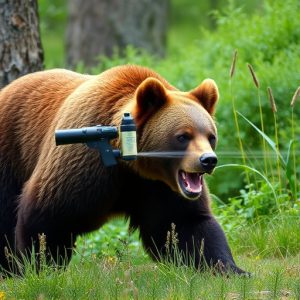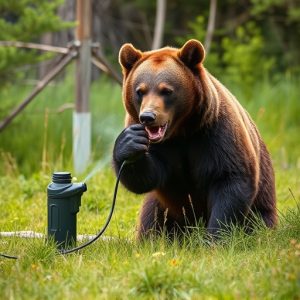Bear Spray Effective Range: Understanding Thirty Feet of Protection vs. Charging Grizzlies
Bear spray, a non-lethal defense against bears, has an effective range of up to 30 feet, but this is…….
Bear spray, a non-lethal defense against bears, has an effective range of up to 30 feet, but this is a rare ideal in practice. It irritates bears' senses, temporarily disabling them. However, when faced with a charging grizzly bear, its limited range (30 feet) and the bear's speed (up to 35 mph) make fleeing or avoiding the bear safer than relying on bear spray. Proper understanding of bear behavior and using bear spray as a last resort are crucial for survival.
“Unraveling the Mysteries of Bear Spray: Range, Effectiveness, and Safety Against Charging Grizzlies. Bear spray, a popular defense mechanism in bear country, boasts an advertised effective range of thirty feet. But what does this truly mean? This article dives into the science behind bear spray, examines the reality of its range, and compares its effectiveness against charging grizzly bears, providing insights crucial for outdoor enthusiasts navigating bear-inhabited areas.”
- Understanding Bear Spray: The Basics and How It Works
- The Reality of Bear Spray Range: Thirty Feet Unpacked
- Bear Spray vs. Charging Grizzly Bears: Effectiveness and Safety Comparisons
Understanding Bear Spray: The Basics and How It Works
Bear spray, also known as bear deterrent or bear repellant, is a specialized pepper spray designed to protect individuals from bears when they encounter them in their natural habitat. Unlike traditional pepper spray used for self-defense against humans, bear spray is formulated to be more potent and long-lasting, with an effective range of up to thirty feet.
When faced with a charging grizzly or black bear, the primary goal is to create enough distance to ensure safety. Bear spray achieves this by emitting a fine mist that contains capsaicin, the active ingredient found in chili peppers. This irritates the bear’s eyes, nose, and respiratory system, temporarily disabling it and allowing the person under attack to retreat safely. The effect is swift but not harmful, making it a non-lethal option for deterring aggressive bears while hiking, camping, or living in bear country.
The Reality of Bear Spray Range: Thirty Feet Unpacked
When it comes to defending yourself against a charging grizzly bear, understanding the effective range of bear spray is crucial. Many believe that bear spray can stop an attack from a distance, but the reality is more nuanced. The commonly cited thirty-foot (10 meter) effective range is a good starting point, but several factors can influence its accuracy and effectiveness.
In ideal conditions, where visibility is clear and the wind is calm, bear spray can reach its maximum projected range. However, in practical scenarios, these conditions are rarely met. The spray’s actual reach can be significantly shorter due to the bear’s natural movements, terrain obstructions, or even the user’s panicked spraying technique. Moreover, bear spray is designed to disrupt a bear’s senses and cause them to retreat; it isn’t always a lethal option, especially at closer ranges where other deterrents might prove more effective against an aggressive bear. Therefore, while thirty feet may serve as a general guideline for responsible preparation, users should be prepared to act swiftly and decisively when faced with an actual bear encounter, regardless of the spray’s range limitations.
Bear Spray vs. Charging Grizzly Bears: Effectiveness and Safety Comparisons
When faced with a charging grizzly bear, the decision to use bear spray can be a matter of life and death. While many believe bear spray is a universal defense against aggressive bears, it’s crucial to understand its limitations, especially when compared to the formidable power of a charging grizzly. Bear spray is designed to temporarily incapacitate an attacking bear by irritating its eyes and respiratory system, allowing the victim to escape. However, its effectiveness diminishes rapidly beyond 30 feet (9 meters), making it less reliable as bears close in.
In direct contrast, grizzlies are incredibly strong and agile creatures. They can run at speeds up to 35 miles per hour (56 kilometers per hour) and charge with tremendous force. A bear spray’s chemical spray might disrupt a charging bear for a few seconds, but the bear could still make physical contact before losing momentum. In comparison, avoiding or fleeing from an enraged grizzly is often the best safety measure. The key to survival lies in understanding bear behavior, maintaining distance, and knowing when and how to deploy emergency tools like bear spray as a last resort.
In understanding the effective range of bear spray, specifically thirty feet, it’s crucial to recognize that while it offers a valuable defense against charging grizzly bears, it’s not a foolproof solution. Bear spray vs. charging grizzlies highlights the importance of proper usage and awareness during encounters in bear country. Knowing the limits of bear spray range and its effectiveness allows outdoor enthusiasts to make informed decisions, ensuring their safety in potential high-risk situations.


